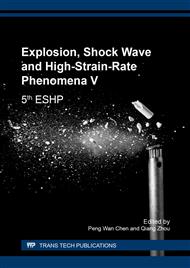p.46
p.52
p.58
p.67
p.72
p.78
p.84
p.90
p.96
Numerical Simulation of Electrical Discharge Characteristics Induced by Underwater Wire Explosion
Abstract:
The underwater shock-wave phenomenon has been applied in various fields such as manufacturing and food processing and was investigated using many experimental and numerical analyses in the past. An underwater shock-wave is produced by various methods, e.g., underwater wire explosion and pulse-gap electrical discharge. Therefore, clarifying the shock characteristics depending on the stored electrical energy, wire dimension and material is extremely important. However, predicting the pressure and its distribution induced by underwater electrical wire explosion is hard because the phenomena associated with an elementary process are significantly complicated. In this study, to predict the discharge characteristics induced by underwater electrical wire explosion, numerical simulation based on the “simplified model of underwater electrical discharge” was performed. The numerical results show good agreement with the experimental ones.
Info:
Periodical:
Pages:
72-77
Citation:
Online since:
January 2018
Authors:
Price:
Сopyright:
© 2018 Trans Tech Publications Ltd. All Rights Reserved
Share:
Citation:


